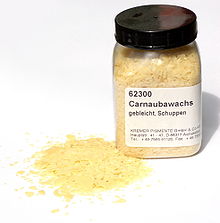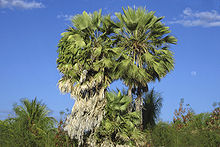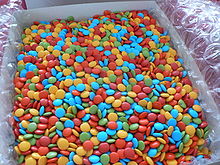- Carnauba wax
-
Carnauba (English pronunciation: /kɑːrˈnɔːbə/ or /kɑːrˈnaʊbə/), also called Brazil wax and palm wax, is a wax of the leaves of the palm Copernicia prunifera, a plant native to and grown only in the northeastern Brazilian states of Piauí, Ceará, and Rio Grande do Norte.[1] It is known as "queen of waxes"[2] and usually comes in the form of hard yellow-brown flakes. It is obtained from the leaves of the carnauba palm by collecting them, beating them to loosen the wax, then refining and bleaching the wax.
Contents
Composition
Carnauba consists mostly of aliphatic esters (40 wt%), diesters of 4-hydroxycinnamic acid (21.0 wt%), ω-hydroxycarboxylic acids (13.0 wt%), and fatty acid alcohols (12 wt%). The compounds are predominantly derived from acids and alcohols in the C26-C30 range. Distinctive for carnauba wax is the high content of diesters as well as methoxycinnamic acid.[3]
Carnauba wax is sold in several grades, labeled T1, T2, and T4, depending on the purity level. Purification is accomplished by filtration, centrifugation, and bleaching.
Carnauba wax can produce a glossy finish and as such is used in automobile waxes, shoe polishes, dental floss, food products such as sweets, instrument polishes, and floor and furniture waxes and polishes, especially when mixed with beeswax and with turpentine. Use for paper coatings is the most common application in the United States. It is the main ingredient in surfboard wax, combined with coconut oil.
Because of its hypoallergenic and emollient properties as well as its shine, carnauba wax appears as an ingredient in many cosmetics formulas where it is used to thicken lipstick, eyeliner, mascara, eye shadow, foundation, deodorant, various skin care preparations, sun care preparations, etc.[citation needed] It is also used to make cutler's resin.
It is the finish of choice for most briar tobacco or smoking pipes. It produces a high gloss finish when buffed on to wood. This finish dulls with time rather than flaking off (as is the case with most other finishes used).
Although too brittle to be used by itself, carnauba wax is often combined with other waxes (principally beeswax) to treat and waterproof many leather products where it provides a high-gloss finish and increases leather's hardness and durability.
It is also used in the pharmaceutical industry as a tablet-coating agent. Adding the carnuaba wax aids in the swallowing of tablets for patients. A very small amount (less than a hundredth of 1 percent by weight. i.e.: 30 grams for a 300 kg batch) is sprinkled onto a batch of tablets after they've been sprayed and dried. The wax and tablets are then tumbled together for a few minutes before being discharged from the tablet-coating machine.
In 1890, Charles Tainter patented the use of carnauba wax on phonograph cylinders as a replacement for a mixture of paraffin and beeswax.
An aerosol mold release is formed by suspending carnauba wax in a solvent. This aerosol version is used extensively in molds for semiconductor devices. Semiconductor manufacturers also use chunks of carnauba wax to break in new epoxy molds or to release the plunger when it sticks. When used as a mold release, carnauba, unlike silicone or PTFE, is suitable for use with liquid epoxy, epoxy molding compounds (EMC), and some other plastic types. Carnauba wax is compatible with epoxies and generally enhances their properties along with those of most other engineering plastics[citation needed].
Carnauba is used in melt/castable explosives to produce an insensitive explosive formula such as Composition B, which is a blend of RDX and TNT.
Technical characteristics
- INCI name is Copernicia Cerifera (carnauba) wax
- E Number is E903.
- Melting point: 82–86 °C (180–187 °F), among the highest of natural waxes,higher than shellac wax or beeswax.
- Relative density is about 0.97
- It is among the hardest of natural waxes .
- It is practically insoluble in water, soluble on heating in ethyl acetate and in xylene, practically insoluble in ethyl alcohol.
References
- ^ Steinle, J. Vernon (September 1936). "Carnauba wax: an expedition to its source". Industrial & Engineering Chemistry 28 (9): 1004–1008. doi:10.1021/ie50321a003.
- ^ Parish, Edward J.; Terrence L. Boos; Shengrong Li (2002). "The Chemistry of Waxes and Sterols". In Casimir C. Akoh, David B. Min.. Food lipids: chemistry, nutrition, and biochemistry (2nd ed.). New York: M. Dekker. p. 103. ISBN 0824707494.
- ^ Uwe Wolfmeier,Hans Schmidt, Franz-Leo Heinrichs, Georg Michalczyk, Wolfgang Payer,Wolfram Dietsche, Klaus Boehlke, Gerd Hohner, Josef Wildgruber "Waxes" in Ullmann's Encyclopedia of Industrial Chemistry, Wiley-VCH, Weinheim, 2002. doi:10.1002/14356007.a28_103.
External links
- Botanical description - from the Mildred E. Mathias Botanical Garden
- GE Chaplin Inc - Custom Manufacturer of Carnauba compounds
- Carnauba wax data sheet - from the UN Food and Agriculture Organization
E numbers Colours (E100–199) • Preservatives (E200–299) • Antioxidants & Acidity regulators (E300–399) • Thickeners, stabilisers & emulsifiers (E400–499) • pH regulators & anti-caking agents (E500–599) • Flavour enhancers (E600–699) • Miscellaneous (E900–999) • Additional chemicals (E1100–1599)
Waxes (E900–909) • Synthetic glazes (E910–919) • Improving agents (E920–929) • Packaging gases (E930–949) • Sweeteners (E950–969) • Foaming agents (E990–999)
Dimethyl polysiloxane (E900) • Beeswax (E901) • Candelilla wax (E902) • Carnauba wax (E903) • Shellac (E904) • Paraffins (E905) • Mineral oil (E905a) • Vaseline (E905b) • Microcrystalline wax (E905c) • Gum benzoic (E906) • Crystalline wax (E907) • Rice bran wax (E908)
Categories:- Waxes
- Food additives
- Cosmetics chemicals
- Portuguese loanwords
Wikimedia Foundation. 2010.



